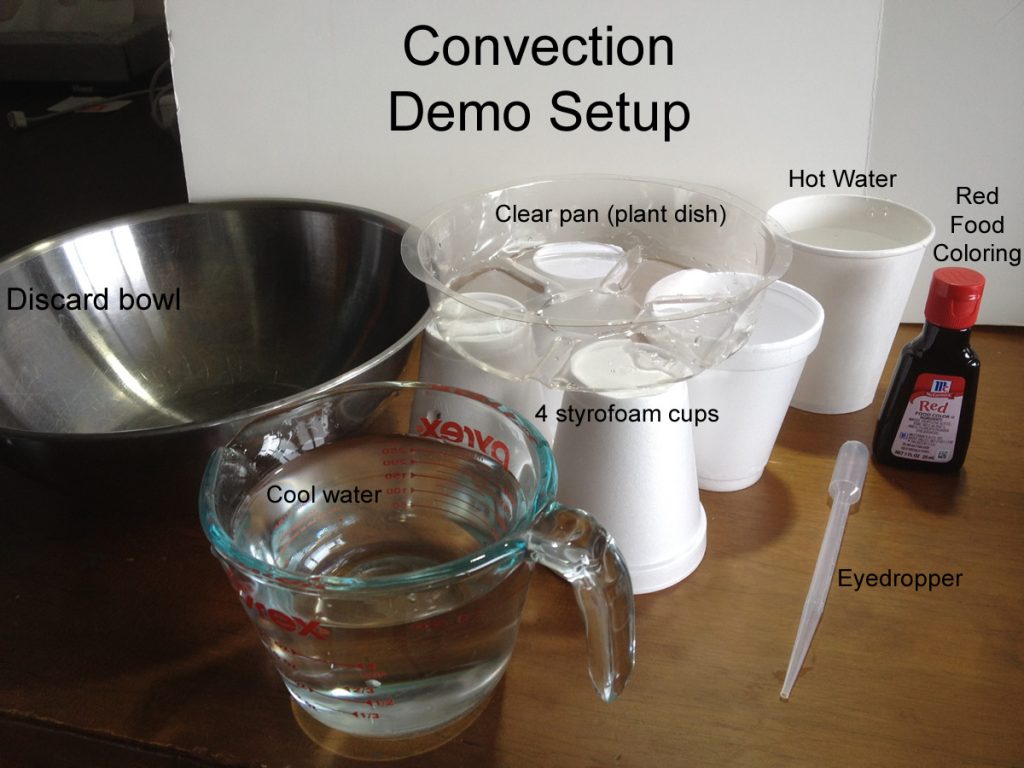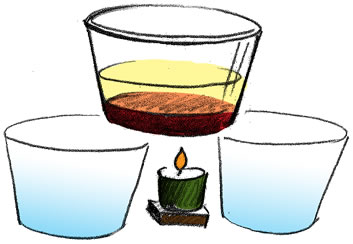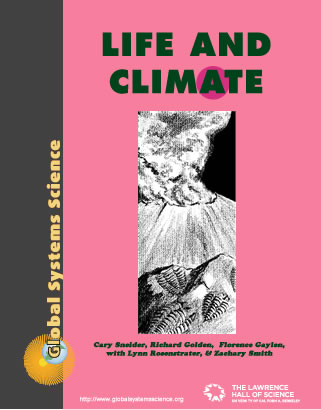LC7.1. Observing Convection Currents
(This activity also appears in GSS Energy Use chapter 3)
Model 1: Adapted from
GEMS Convection Activity
This model uses water, food coloring as a marker of currents in the water, and a cup of very hot water as a heat source. Movie clips of setup and convection in action are included on this page.

Materials
- Clear pan (plant dish)
- 4 styrofoam cups
- Food coloring
- Eyedropper
- Hot water (scalding hot is best)
- Cool water (room temperature, or so)
- Discard bowl
What to Do
- Setup materials as shown in the photo above. Note that the 4 styrofoam cups support the clear plastic dish and that 3 are upside-down and one is right-side-up. The right-side-up one will hold the hot water (duh).
- Pour cool water into clear plastic dish, making it fairly full and allow a few minutes for the water to come to rest. Meanwhile…
- Get hot water ready (e.g. movie shows heating water in a microwave).
- With the eyedropper, put a pool of food coloring in the bottom middle of the pan, off to one side of where the hot water cup is.
- Pour the hot water in the right-side-up cup and slide the cup under the pan, near where the pool of food coloring is on the bottom of the pan.
What to look for:
- upward current over the heat source
- lateral current at top of water surface AWAY from the heat source
- lateral current at bottom of water TOWARD the heat source.
Here is a movie of “Convection in Action”
Model 2:
Candle, Oil, and Water: Observing Plumes

The outer core of the Earth is hotter and denser than the lower mantle, which lies just above it. The core consists of molten metal, mostly iron. The mantle is made of rock which is considerably lighter than the metal core. The hot core heats the mantle gradually by conduction, starting a convection current. If the temperature difference is great enough, a huge plume of molten rock will expand and break away from the mantle-core boundary and float up until it reaches the crust, causing rifts and volcanoes. The following simulation will help visualize this process. You can do this in the lab—or in your kitchen.
Materials
- 1 Pyrex™ beaker or clear custard cup
- 1 votive candle
- 1 bottle of red food coloring
- 250 ml (1 cup) of water
- 250 ml (1 cup) of mineral oil
- 1 ring stand or two short glasses
What To Do
1. Pour 250 ml (1 cup) of water into the clear cup or beaker. Make sure the cup is made of Pyrex™ or some other glass that will not crack when heated.
2. Put two or three drops of red food coloring into the water and stir it.
3. Pour 250 ml (1 cup) of mineral oil into the cup. It will float on top of the red-colored water.
4. Arrange the ring stand or two glasses (as shown) so the candle can be placed under the cup, about half-way to one side.
5. Light the candle and adjust its height so the cup is just above the flame.
6. Watch for 15-20 minutes. Observe slow convection currents and look for red plumes. What happens to them? Move the flame so it’s at the center, or edge of the cup. What happens? You can try out other ideas, such as adding ice, to see how currents change.
7. Compare what occurs in your experiment with what occurs inside the Earth.
This convection investigation is designed to help you visualize convection currents. The bottom of the glass cup or beaker is heated by radiation from the candle flame. (It is also heated by hot air that rises just above the flame.) The water in the glass container is then heated by conduction, as molecules in the glass start to move faster, eventually colliding with molecules in the water, causing them to move faster too. When the water gets hot enough, it will start a slow, steady convection current, which you will probably see by the movement of tiny bubbles if you look closely enough. Eventually, a mass of water becomes hot enough to float up through the layer of mineral oil, where it erupts on the surface before falling back again. In other words, your laboratory simulation may demonstrate both kinds of convection currents that we see in the Earth—the slow steady convection current that drives tectonic plates, and the occasional plume or superplume.
In later chapters, the idea of convection will apply to energy flow in the Earth’s atmosphere, as well as energy flow in the interior of the Sun. Basic ideas about energy sources and energy flows give us mental tools for understanding the entire Earth system—from the center of the Earth’s core to the environment of outer space.


